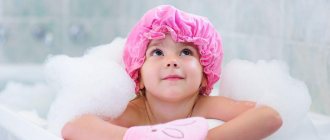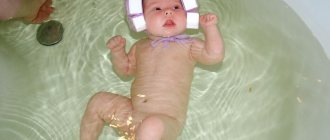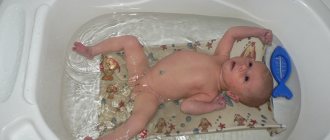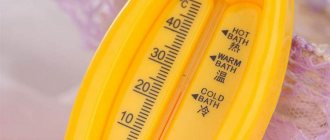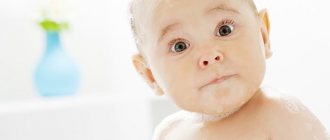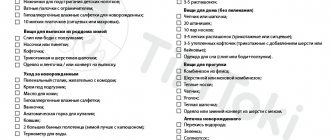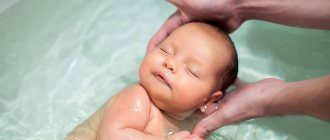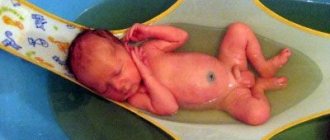After being discharged from the maternity hospital, young parents have many questions and doubts about caring for their baby. One of these problems is bathing a newborn baby.
Bathing the baby
Bathing is not so much a hygienic event as an important element in the growth and development of a baby. Water procedures have a beneficial effect on the emotional, mental and physical state of the baby, relieve muscle tone, and stabilize blood circulation.
Frequency of baby bathing
Until now, pediatricians have not given a clear answer to the question of how often to bathe a newborn baby up to a month old. Some believe that the baby does not get dirty to such an extent that it needs daily bathing. In addition, the baby’s immunity is just developing, and there is no need to subject it to tests. Others, on the contrary, consider daily bathing necessary.
Which of these opinions is correct, parents decide based on the baby’s well-being and some external conditions.
Daily bathing of a 1 month old baby
A newborn baby is bathed for the first time after a crust has formed on the navel. 2-3 days after discharge from the maternity hospital, when such a crust has already formed, parents begin bathing the baby.
A healthy baby at 1 month of life is bathed daily, but without the use of soap, antibacterial agents and herbal decoctions.
Important! Using detergents more than once a week can disrupt the formation of microflora on the baby’s skin and cause a tendency to irritability and dryness.
Bathing baby with detergents
Many mothers use chilled boiled water to wash their one-month-old baby until the umbilical wound heals. Not all experts consider this correct and recommend using just clean water without any impurities. Frequent use of decoctions or herbal infusions is also not always justified. Bathing in a weak solution of potassium permanganate dries out the baby's skin, but prevents infection from entering the unhealed umbilical wound.
Neglect of child hygiene does not prevent:
- the appearance of diaper rash on the neck, bends of the arms and legs;
- the appearance of heat rash, especially in the hot season;
- deterioration of the baby's well-being.
At the same time, bathing has a positive effect on the baby:
- muscle tone is reduced,
- blood circulation is activated,
- the skeleton is strengthened,
- muscles develop.
In the hot season, daily bathing is mandatory; in the cool season, parents and pediatricians consider it normal to skip several sessions, especially if adults do not have the opportunity to warm the room to a favorable temperature.
Optimal frequency of bathing babies
After analyzing the opinions of experts on the optimal frequency of bathing infants, the conclusion arises that the decision on how often to bathe a newborn child is made by parents. The frequency of bathing depends on the health status of the little one and external conditions (for example, the time of year).
If in winter mothers and fathers do not achieve the optimal temperature in the room, and the baby gets cold after bathing, then they limit themselves to 2-3 baths per week.
In the warm spring, the baby is bathed every day. Every week they lower the temperature of the water by 1 degree and begin hardening the baby. It is believed that in the spring the hardening process is more effective.
In hot summer weather, babies are bathed several times a day. This prevents the appearance of heat rash and diaper rash. Frequent water procedures provide the baby with a comfortable state of health in the heat.
In autumn, bathing is carried out no more than once a day. At the same time, they closely monitor the baby’s health. If you feel unwell, bathing is postponed until next time.
Regardless of the number of baths, be sure to wash the little one in the morning and wash them as needed.
Baby screams while bathing: what to do?
Let's say the child was absolutely calm, but as soon as he plunged into the water, hysterics began. The bathing technique is not broken, but time after time everything ends in crying. How to fix it? Since all children are individual, the approach to solving the issue must be appropriate.
Let's try to change:
- feeding time - for example, not after bathing, but before it;
- time of the procedure, for example, from evening to mid-day or morning;
- water temperature - as a rule, the baby is cool and needs to be made warmer. Parents themselves decide at what temperature to bathe the child, but in reality there is a so-called “temperature contrast”: the baby lies wrapped up, warmed up, and then they carry him and lower him into water of about 25 degrees. Hence the emotion - a cry of protest due to discomfort. To make it different, it is recommended to come up with and carry out a certain ritual immediately before swimming. For example, undress the baby and walk your hands along the massage lines with the words: “Now we’ll go for a swim, warm water is waiting for us.” Cool the water itself gradually, after the baby has immersed himself in it. And, of course, swim with toys.
Room and water temperature
A child has confused day with night: what to do?
When bathing the baby, the home and bathroom are maintained at the optimal temperature. Some caring parents heat the room well for bathing the baby, especially in the cold season. Doctors, including Dr. Komarovsky, think this is wrong. According to standards, the degree of air heating in the washing room does not differ from the temperature in the entire apartment. The desired temperature for a baby's life and bathing is 18-22 degrees. Exceeding these indicators will not be beneficial for the baby.
For the first two weeks, the temperature of the baby’s bathing water reaches 370. Then this figure is reduced, but no more than 1 degree weekly. Gradually, the water temperature for daily swimming is adjusted to 27-28 degrees. To prevent the little one from getting too cold in the cooling bath, always carefully add hot water while bathing.
The degree of water heating is monitored using special water thermometers. Sometimes parents use the “grandmother’s” method and control the temperature of the bathing water with their elbow. The method is not the most accurate, but it is accessible to everyone without exception.
When washed in hot water (36-37 degrees), the baby relaxes and calms down well, then quickly falls asleep. But a hardening and healing effect is not observed in this case.
Relaxing bath for baby
Why is it necessary to take a shower after water procedures in lakes or rivers?
Every year, with the beginning of the swimming season, we remember about cercarial dermatitis (popularly called cercariasis).
This is a parasitic disease of waterfowl or animals, from which humans sometimes suffer and which has long settled in Belarusian water bodies. In many countries, this problem is called “swimmer’s itch,” and even abroad this disease is usually called “schistosomatid dermatitis.” Why does cercariae affect people and how to protect yourself from unwanted contact with the larvae? “Cercariasis occurs as a consequence of the introduction of larvae or cercariae of avian helminths into the human skin when swimming in a natural (usually stagnant) body of water,” explains Tatyana Dorozhenkova, Candidate of Biological Sciences, Associate Professor of the Department of Epidemiology of BSMU
. — People become accidental victims of cercariae, which mistakenly take them for an object suitable for further development, for example, a waterfowl.
— How common is cercariasis in the world?
— Many countries can “boast” of the presence of this parasitic disease, including the USA, Canada, France, Czech Republic, Germany, Sweden, Hungary, New Zealand and others. According to scientists, more than 90 countries have encountered schistosomatid dermatitis in different years. There are foci of cercarioses in Belarus, in almost all regions, but we usually do not suspect their existence. According to Belarusian scientists, there are about 500 cercaria-hazardous reservoirs in the country.
- Usually only Naroch is heard.
— Yes, this lake has become especially famous “thanks to” cercariasis. Currently, Lake Naroch is an integral part of the Narochansky National Park, which is classified as a specially protected natural area. And in the 80-90s of the last century, local residents and vacationers swam in the same place where wastewater was discharged. Wild waterfowl nested and fed nearby. After swimming in the lake, people often complained to each other about itching, but they did not know who to contact, and the doctors were not familiar with the symptoms of schistosomatid dermatitis.
This situation would have continued for quite a long time, but scientific reports on the study of cercarioses in other countries became a trigger for a scrupulous analysis of the causes of itching after swimming in Lake Naroch. I can say without exaggeration: when the study of cercarioses began, the incidence was hundreds of times higher than it is now. For comparison, I’ll give a few figures: in 2010, the official incidence of cercariasis was more than 370 cases, currently there are single complaints (in 2019 - two cases, in 2020 - one).
— Is cercariosis a seasonal phenomenon?
- Yes. As soon as the water temperature rises above 16 degrees, we can expect the appearance of cercariae from gastropods, which are their intermediate hosts. The higher the average daily air temperature, the more intensively the water surface warms up, the sooner people want to plunge into the water. At the same time, the cercariae leave their hosts.
Usually in shallow water in the coastal part of a reservoir, where there are aquatic plants, you can easily find mollusks - ordinary limneids or planorbids. And if they were infected, then here, attached to aquatic plants or even “hovering” in the water, there will be cercariae that have left the mollusk and are waiting for waterfowl. This is the real main host, in whose body the cercaria is transformed into a sexually mature trematode - a helminth from the class of flukes. This is how it turns out that if there are infected shellfish in a pond and it is used for swimming, cercarioses will be recorded in people. There is a direct relationship between the frequency of infections and air temperature: the hotter the summer, the more often there will be calls to medical workers with complaints of itching after swimming. The lower the water temperature in the reservoir, the longer the period of maturation of cercariae. At the same time, the peak incidence of cercarial infections in humans is shifting.
— Tatyana Evgenievna, how can you understand that this is cercariosis and not dermatitis, since itching is a typical symptom of many skin diseases?
— The pathogenesis of cercariasis has a clear explanation. Firstly, it is always associated with mechanical damage to the skin or mucous membranes during the introduction of larvae. Secondly, with the sensitizing effect of metabolic products of cercariae (or the decay of dead larvae). And thirdly, with the impact of decay products of tissues damaged by larvae. After contact with the cercariae, after 10-15 minutes, a slight tingling sensation will be felt in the places where the larvae are embedded. After a few hours, an itchy, hives-like rash appears. Body temperature rises to 38-39 degrees, weakness, dizziness, and insomnia may occur.
Photo by Tatyana Stolyarova
At first, the symptoms really resemble dermatitis. However, later the pathological picture fully corresponds to the classic description of schistosomatid cercariasis with swelling, blisters, unbearable itching, severe burning and pain in the affected areas. Sometimes the described symptoms are accompanied by a dry cough. In blood tests of an infected person, moderate leukocytosis and eosinophilia can be detected.
With repeated infections, the swelling of the affected areas of the body increases even more. If cercariae enter the bloodstream, they can be carried into the lungs, which can lead to pulmonary syndrome. And with intensive infestation by cercariae, a severe anaphylactic reaction may develop. So this disease cannot be underestimated.
The diagnosis is usually made based on the history and clinical picture. Specific therapy has not yet been developed, so treatment of cercariasis is symptomatic: the doctor prescribes itching creams and ointments, and for insomnia, sleeping pills.
“It’s clear that dissuading people from swimming in reservoirs in the hot summer is a waste of time. It turns out that prevention of cercariasis simply does not exist?
- Why, you can use creams or repellents containing dimethyl phthalate, diethyltoluamide, which are applied to the skin before bathing. However, you need to understand that they only last for a short time. Nevertheless, within 1.5-2 hours they can prevent an attack by cercariae. After contact with the water of a cercaria-hazardous reservoir, you must take a shower or rub yourself with a hard towel.
In general, for effective prevention of cercariasis, it is necessary to carry out awareness-raising work among the population. On the eve of the swimming season, it is important to explain to people what the essence of the problem is, the ecological and biological features of the behavior of cercariae and their intermediate hosts - mollusks. In my deep conviction, it was thanks to targeted explanatory work that it was possible to reduce the incidence of cercariasis in Naroch hundreds of times. By the way, the latest cases of this disease there were associated with swimming of “wild” tourists in shallow areas with unequipped beaches.
In many sanatorium and resort areas of Belarus, there are swimming pools at the sanatoriums. And in order to avoid schistosomatid cercariasis, it is better to use them. By the way, this is what most residents of Western European countries do, and the natural bodies of water in which cercarioses have been recorded belong only to waterfowl, fish and shellfish.
ON THE TOPIC
Healthily assess the risks of swimming in natural bodies of water. We are talking about those where mallards, swans, gulls and other birds live, there are thickets of aquatic vegetation, and shellfish can be found in shallow waters. It is in such places that the likelihood of infection with avian schistosome larvae will be high. Yes, in our country there are protected areas with beautiful reservoirs, but they are protected not from waterfowl or lung mollusks, but only from stray animals. The status of a protected area with a reservoir does not mean that there is guaranteed to be no contamination with cercariae when swimming.
Time and duration of bathing
Gymnastics for a 6 month old baby
The duration of water procedures depends on the age and condition of the baby. For the first time, the child is bathed quickly, for 3-4 minutes. Each subsequent bathing is extended by 1-2 minutes. The optimal duration of water procedures is from 15 to 20 minutes. If parents see that the baby enjoys bathing, then the procedure is extended a little, but staying in water for a long time also has negative consequences.
Safety rules while swimming:
- prepare in advance clean clothes, a towel and products necessary to care for the baby’s skin;
- cover the changing table with a soft towel and diaper;
- prepare water in advance for the bath and for rinsing the little one;
- Be sure to check the water temperature before immersing your baby in it;
- under no circumstances should the baby be left alone in the bathroom; the presence of bathing accessories does not guarantee safety;
- add warm water so that the baby’s delicate skin is not damaged;
- Water treatments are canceled if the baby has a high fever or other ailments.
Most often, the baby is bathed in the evening before bed. The optimal time for this every day is between 20.00 and 21.00. Sometimes parents organize water treatments for their infants at other times that are convenient for them and the baby. Usually, the baby is bathed 30 minutes before feeding and some time after waking up.
E. Komarovsky believes that evening bathing has its advantages: the procedure relaxes and calms the child, this contributes to a sound and healthy night's sleep.
When and for how long to bathe a baby
As for the bathing schedule, any time of the day is suitable for taking a bath.
Important! Water treatments should be avoided immediately after feeding, as this can cause regurgitation.
Many parents consider the best time to be in the evening, when bathing becomes a ritual before falling asleep. It promotes healthy sleep habits, helping your baby relax.
The duration of the first baths is no more than 3 minutes, gradually it can be increased, bringing it to 20 minutes.
Important! You should not allow your baby to stay in water that contains foam from soaps and shampoos for a long time.
Bathing and washing
The process of washing the baby is purely hygienic, ensuring the cleanliness of the diaper area, and bathing helps to improve the physical and emotional state of the baby and the formation of mutual affection between him and his parents.
Washing the baby
Difference between bathing and washing
How to develop a child at 4 months - educational games and activities
During the day, the baby repeatedly empties the intestines and bladder. To avoid skin inflammation, infection and irritation, the child’s genitals and bottom are washed under running water. Do this before every diaper change. In emergency cases, use baby wipes, but if possible, use plain water.
Important! Wet baby wipes contain chemicals that are harmful to the baby's delicate skin.
Almost all parents understand why bathing is not replaced by washing. Washing is a hygienic procedure that helps keep the baby's body clean. Bathing is considered not so much as a hygienic procedure, but as a means to stimulate and strengthen the immune system, one of the ways to physically develop a baby, and a source of positive emotions.
Instructions “First bathing of a newborn at home after the maternity hospital”
All necessary steps are described here:
Prepare the bath (treat with soda, soap and rinse well so that no detergent residue remains on the walls). Fill up with water t=36-37 °C to a level of 12 cm, add a solution of potassium permanganate if necessary. Before the bath, girls are washed under running water from front to back, protecting the genital slit from feces. Boys - from butt to belly. Before diving, wrap your baby in a thin swaddle to hydrate and prevent fright. This is necessary in order to create something similar to the conditions of intrauterine stay - restriction of movements + aquatic environment. With your left hand, take the baby by the armpit so that the thumb fixes the shoulder, and the palm is located in the armpit (the head should be at the bend of the hand). Support your back with your right hand. Use a stand that follows the curves of the body, a hammock (if you have one at home, it’s very convenient for the first time). Slowly lower the baby: first the legs, then the body. The head end should be raised, the chest half covered with water
Water carefully so as not to frighten the baby. With your palm downwards, wash your face and eyes. Unroll the diaper, alternately opening and closing parts of the body after ablution.
Rinse the folds and parts of the body one by one in the following sequence: neck, armpits, each finger, head from the forehead to the back of the head, groin areas. Constantly water each washed area that is above the surface of the water to keep it warm. Lastly, carry out hygienic actions in the perineum. Wash the genitals of girls carefully and carefully remove the discharge. In boys, mucus accumulates under the foreskin, carefully open and rinse.
How to finish bathing a newborn baby
Lift the baby over the bath and rinse with prepared water from the ladle. Wrap in a baby towel. Transfer to a table with a soft mat and blot the body. Do not rub delicate skin - it can be damaged. Let your baby lie down for 5-10 minutes.
At this time, lubricate the folds with sterile vegetable oil (cream). Treat the umbilical wound alternately with 3% hydrogen peroxide and brilliant green solution.
Lightly wipe the eyes, from the outside to the nose, with a damp cotton swab.
Treat the nasal passages and ears with cotton wool. For each ear, use a new turunda.
If necessary, trim your nails carefully.
After all hygiene procedures, dress the baby. Hands, feet, and head quickly cool down. We put on socks, scratchies, and a cap.
To swaddle tightly or not, which is better?
Tight swaddling makes physical activity difficult. Free movements contribute to the development of intelligence. Up to 2 months, the baby is afraid of open space.
Now you are prepared, practice and improve the technique of bathing your baby and the fears of the “first time” will disappear completely. Learn how to bathe your newborn so everyone can enjoy the experience. Good luck and patience.
The material was prepared with the participation of a neonatologist of the highest category, head. department of the 2nd stage of nursing of premature babies Gerbek S.E.
Bathing a child in a large bath
Not many parents decide to bathe their baby in a large bathtub, as they fear for the baby’s safety. A large bathtub provides more opportunities for games and activities with your baby, even for practicing swimming skills.
Bathing in a large bath
In order to save water and limit space, manufacturers offer special limiters in a large bathtub for bathing a baby. A bath mat with pockets allows you to comfortably kneel while bathing your baby in a large bathtub. The pockets contain everything you need for swimming. Needlewomen make such a rug themselves.
Rules for bathing in a large bath:
- The procedure is organized for babies with a healed umbilical wound.
- The water temperature must be monitored throughout the entire procedure.
- The child is lowered into the water gradually: first, the arms and legs are wetted, and only then the torso.
- Hold the baby correctly. The adult's little finger is located in the area of the baby's neck, the remaining fingers are in the area of the back of the child's head. In this position, the toddler’s body floats well above the water.
- Make sure that water does not get into the baby’s mouth and nose.
- With his free hand, the adult regulates the degree of immersion of the baby in the water.
- When bathing for the first time in a large bath, they leave time for the baby to get used to the large spaces, only then they begin to move the child in the water and in this way activate his movements.
- To facilitate the exploration of a large expanse of water, the little one wears a special inflatable ring, which has a recess for the chin and a Velcro fastener on the neck.
After adapting to this method of bathing, they begin to master the basic poses:
- lying on your back with your head supported,
- swimming on your stomach (with your chin supported between your thumb and index finger),
- sitting posture.
Important! If bathing in a large bath does not bring pleasure to the baby, then this procedure is postponed or postponed until the age of 2-3 months.
What to add to bathing water
By and large, you don’t have to add anything. An infant child can be quite successfully bathed in ordinary tap water, provided that it is more or less clean. But if you still really want to somehow “flavor” the bathing water, then it is best to use a decoction of the string. Why not potassium permanganate and a supposedly calming herb?
Potassium permanganate. Every grandma's favorite substance. But while it can also be useful for washing newborn babies, potassium permanganate is ineffective for bathing a baby in a large bath: if it is diluted to a soft pink color, then its anti-inflammatory properties are extremely small, and if diluted in concentrated form, there is a risk of “burning” » delicate mucous membrane of the eyes.
Herbal soothing mixtures. As Dr. Komarovsky often jokes, pediatric neurologists are very fond of prescribing such preparations for young mothers. They tell them that these herbs calm children before bed, but in fact they give reasons for self-soothing... for mothers themselves! E.O. Komarovsky: “If a child has neurological problems, then no herbs, alas, will help him, even if he is “rinsed” in them around the clock. And if there are no problems as such, then there’s no point in collecting fees.” One way or another, there is not yet a single serious study that has confirmed that a certain herb added to water for calming would bring truly tangible results.
A series. Perhaps this is the most useful “seasoning” for infant bathing. It has a certain antibacterial and healing effect, but is completely safe for the baby’s delicate mucous membranes. And if there is any point in adding something to the water before bathing a baby, it would be a decoction of the string.
How to brew a string for bathing:
- In the morning, pour a glass of dry herb (sold in packs at any pharmacy) into a liter container for hot water, the easiest way is into a glass jar.
- Pour boiling water to the top (that is, to get 1 liter of liquid). And set aside - let it brew until the evening.
- Before bathing, pour the broth through gauze into a bathtub of water. And now you can “launch” your baby into such water. It is not necessary to rinse the baby after bathing in a decoction of the string, but it is not forbidden either. It makes sense to practice baths with a series in approximately the first 2-3 months after birth.
Bathing in a baby bath
Most parents prefer bathing in a special bath. This causes less trouble for adults and makes it easier to control the baby.
What types of bathtubs are there:
- Classic bath for babies. It has an anatomical shape and is comfortable for adults and children. Designed for a child up to 3 months.
- With an antimicrobial layer, which, if used correctly, disinfects the surface of the bath for a long time. A convenient accessory, but also quite expensive.
- The thermal bath is equipped with a built-in thermometer and a reservoir for liquid soap or shampoo.
- An inflatable bath is used in country or camping conditions.
Along with the bathtub, other bathing accessories are usually purchased, these are:
- a slide or hammock that keeps the child in a reclining position,
- a jug or ladle with a lid for rinsing the baby (water is poured into it at the same time as the bath and cools down a little at the time of rinsing, which has a beneficial effect on the baby’s body),
- water thermometer,
- baby soap (liquid or bar), pH neutral shampoo, skin oil, soft sponge.
Bathing in a small tub
The procedure for bathing a baby in a bathtub:
- the container is thoroughly treated with soda solution and rinsed several times;
- fill 2/3 of the volume with water, check the water temperature;
- then the baby’s head is placed on the bend of the elbow, the butt is held with the palm of the hand;
- carefully immerse the child in the water: lower the legs first, then the torso to the middle of the chest; if there is a slide or hammock, first install the accessories correctly, make sure they are safe, and only then place the child on them;
- Gently wash the folds on the child’s skin without a washcloth or soap;
- turn the baby over;
- rinse with water from a jug from head to toe;
- wrap the baby in a soft diaper.
Important! Bathing definitely evokes positive emotions in the baby. To do this, the adult speaks affectionately to the baby during the procedure.
Swimming in a good mood
Water temperature for bathing a newborn
As mentioned above, the water temperature directly depends on the time of year, the duration of swimming, the size of the bath and the activity of the child. On average, a comfortable temperature is considered to be between 33-37 degrees.
Monitor it with a safe mercury-free thermometer and add warm water little by little if necessary (just do not pour boiling water so as not to scald the baby).
In a deep bath, if the baby is actively moving, you can gradually lower the water temperature - by about 1 degree per week, bringing it to 29-30 degrees. This technique will help to toughen up the baby a little.
Whether or not to add herbs to the water is entirely your decision. It is worth noting that there are no scientifically proven facts yet confirming the calming effect of adding lemon balm or valerian decoction to water. But you can add string or chamomile - these herbs help to heal the baby’s skin faster if there is irritation or diaper rash.
To prepare the decoction:
– Take a glass and pour dry herbs into it, pour boiling water over it overnight (you should get 1 liter);
– Before bathing, pass the resulting herbal decoction through fine gauze;
– Pour the broth into the prepared water in the baby bath and stir lightly.
And remember: there is no point in bathing a child with a healed navel in boiled water.
Procedures necessary after swimming
A small child is not wiped, only his skin is blotted with a soft towel or diaper with a sewn corner for the head. Then they place the baby on the changing table and examine the body to identify rashes and diaper rash.
After bathing, the umbilical wound is treated. Normally, it heals within 2 weeks, but requires daily attention. To reduce the risk of infection, the baby is first bathed in boiled water or a weak solution of potassium permanganate.
The skin of a healthy child does not require the use of creams, oils and other products. In case of problems, Dr. Komarovsky advises: “Wet - dry, dry - moisturize!”
Pediatricians recommend treating dry areas with baby oil, and combating redness in the folds with powder or talcum powder. Baby cream is used to treat wrinkles on the body and prevent diaper rash. A cream or spray containing panthenol is necessary for healing diaper rash and dry skin. Baby powder and talcum powder reduce moisture in problem areas.
Important! Powder or talc should not be poured onto the baby's skin. They are applied to the hand and treated with folds.
Milk or lotion is good for preventing dry skin and does an excellent job of flaking the skin on the palms and soles.
Note! Any care products are applied to dry skin.
Before dressing, wipe the ears. The cap is put on first, then the diaper. Only after this is the baby dressed or swaddled. Some experts recommend swaddling your baby for good sleep.
After properly performed water procedures, the baby is in a good mood, ready for feeding and early sleep. Bathing is a mandatory procedure for a newborn baby, necessary for its full growth and development. It does not require special medical knowledge and skills from an adult.
When is the best time to bathe and for how long?
It is more convenient for most parents to organize baby swims in the evening, before the last feeding, an hour before bedtime. But all babies are different. Some people protest the idea of bathing at this time and become cranky because they want to eat.
You can try swapping bathing and feeding. But between bathing and feeding, some time should pass, at least 15-20 minutes. If the baby is more comfortable this way, then so be it. Bathing should evoke only positive emotions.
Most often, children sleep well after floundering in the water. But there are also those, according to statistics about 10%, who, on the contrary, become active and do not fall asleep for a long time. In this case, bathing must be moved to the morning or afternoon.
The first bath of a newborn should not be long, try to keep it to 5 minutes. Gradually increase the time your child spends in the bath. By the end of the first month of life, this can already be 10-15 minutes, and a six-month-old baby can swim for 30-40 minutes.
Do you need to bathe your baby every day?
According to many professionals, excessive use of water washes away the protective film from the child’s skin, the skin becomes drier, redness and peeling appear.
Moreover, in families that strive for sterile conditions for their baby, diseases manifest themselves more often, especially allergic diseases.
Therefore, Russian pediatricians advise bathing children under 6 months of age no more than once a day, or even less often.
Considering that babies hardly get dirty, washing and rinsing is enough. There are wet wipes for hands and face, and to prevent diaper rash, you need to make sure that the baby does not lie in a wet diaper.
